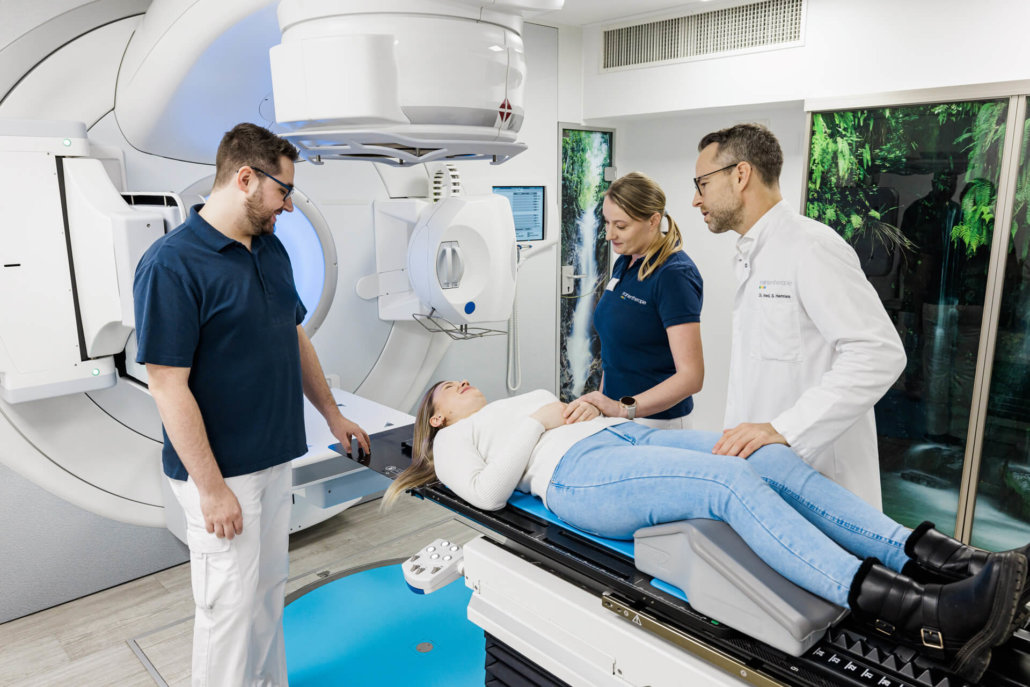Metastases of the adrenal glands – lung cancer is often the cause
Adrenal metastases arise from cancer cells that have entered the adrenal gland via the blood from the primary tumor. The daughter tumors (metastases) are therefore not composed of cells of the adrenal gland, but of cells of the tissue or organ in which the main tumor is growing. The most common cause is lung cancer, less frequently tumors of the mammary gland or gastrointestinal tract.
Find metastases of the adrenal glands beforehand!
Adrenal metastases would often go undetected unless appropriate screening was performed due to cancer follow-up. The different imaging methods can provide different information. Using CT, MRI and PET/CT, our specialists at Radiologie München make the appropriate diagnoses.
Where can you have adrenal metastases irradiated in Munich?
To create an individualized treatment plan, it is crucial to first determine the origin of the adrenal metastases, i.e. the main tumor, as tissue cells react differently to certain forms of therapy.

How are adrenal metastases treated?
Daughter tumors of malignant tumors, usually originating in the lungs, often also settle in the adrenal gland. Their therapy depends on how far the underlying cancer has progressed. In principle, surgery or radiotherapy, usually as stereotactic radiotherapy, may be considered as local procedures.
Whether an adrenal metastasis is treated locally depends on the dynamics of the overall disease. It makes the most sense when the adrenal metastasis is isolated as the only metastasis (oligometastatic stage) or when only the one adrenal metastasis grows under system therapy when multiple metastases are known (oligoprogressive stage).
What does oligometastasis mean?
Oligometastasis defines the appearance of single metastases from a primary tumor. Radiotherapeutic treatment of these metastases produces good results and prolongs progression-free survival.
What does Oligoprogression mean ?
Oligoprogression describes a condition in which further progression of disseminated metastases occurs after an initially successful systemic therapy.
Radiotherapy
Adrenal radiation is usually given in addition to or as an alternative to chemotherapy. Along with surgery, it is the alternative to local treatment. High-energy radiation is used to target the adrenal gland through the skin (percutaneously). By focusing the beams on the metastasis, the surrounding tissue is largely spared while the cancer cells are destroyed.
Stereotactic radiotherapy uses modern imaging techniques for pinpoint radiation. This can ensure good tumor control. At the same time, the side effects remain low.
What does stereotaxy/stereotactic radiation mean?
Stereotaxy describes a treatment method that uses image-guided and computer-assisted targeting systems to enable precise control of the patient’s position in relation to the therapy device, so that very accurate radiotherapy or surgery can be performed.
Radiation therapy is small-volume and precise. The surrounding normal tissue remains only slightly exposed to radiation.
Operation
Surgery is an option for patients if it is a single, localised metastasis. In this case, the adrenal gland can be surgically removed or the metastasis is removed with the help of minimally invasive surgery.
Chemotherapy
Chemotherapy involves the use of drugs (cytostatics) that inhibit fast-growing cells from growing and spreading. The goal of this treatment is to inhibit cell division in order to shrink metastases and prevent their reformation.
Both chemotherapy and radiation therapy are used primarily for advanced disease.
What is the treatment process in our practices?
What do you need to keep in mind during the course of treatment?
If a patient is found to have metastases, it is usually a sign that a cancer has already progressed and that cancer cells have spread to other organs. The first priority is always to treat the main tumor. Afterwards or still during this treatment, the metastases are treated. The prognosis for cure and the life expectancy of patients depends primarily on the stage of the disease and the type of cancer of the main tumor.
Regular follow-up examinations are important because the doctor can react very quickly in the event of a relapse (recurrence) and initiate therapy. As part of these follow-up examinations, a CT and/or MRI and an oncological examination will provide information about the patient’s general condition. Talking to the patient is also important, as they can communicate any worsening of their condition to the attending physician.
What are the side effects of adrenal metastasis treatment?
Despite careful planning of the treatment plan, side effects cannot be ruled out during the course of treatment and for some time afterwards. The adrenal gland plays a crucial role in hormone balance. An overfunction, underfunction or malfunction of the adrenal gland can therefore have far-reaching consequences.
Surgery always carries a certain risk. If parts of the adrenal gland or the entire adrenal gland must be removed during surgery, it may result in impaired or failed function of the adrenal gland. It may be possible for the second remaining adrenal gland to partially take over the function of the metastatic adrenal gland. However, patients may also need to take the hormone cortisol temporarily or permanently.
Chemotherapy drugs unfortunately not only damage cancer cells, but also attack rapidly dividing healthy cells. These include blood, hair and mucosal cells. Therefore, fatigue, reduced immunity, hair loss, nausea, diarrhea and mucosal inflammation are among the most common side effects of chemotherapy.
Modern radiotherapies are planned in such a way that mainly cancer cells are destroyed and the surrounding tissue is spared as much as possible. Nevertheless, irradiation can be perceived as stressful. Patients often feel exhausted after treatment. In addition, skin irritation or scarring of the skin, inflammation, nausea and diarrhea are observed.




